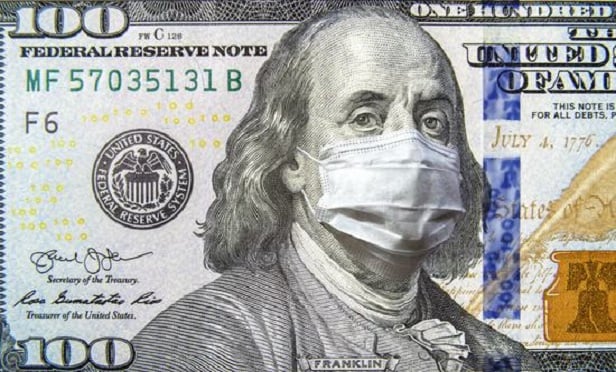 For a peril to be covered, the chance of loss must becalculable. For a pandemic, it could be based on an individual'ssalary or the monthly income of a business. (Photo: ViacheslavLopatin/Shutterstock.com)
For a peril to be covered, the chance of loss must becalculable. For a pandemic, it could be based on an individual'ssalary or the monthly income of a business. (Photo: ViacheslavLopatin/Shutterstock.com)
By May 2020, it was quite clear that the United States — alongwith the rest of the world — was deeply involved in a deadly andeconomically disastrous COVID-19 coronavirus pandemic, and therewas little individuals or corporations could do to help themselvesexcept to turn to governmental (state and federal) programs. Butscientists and medical experts had been warning for decades that apandemic was "overdue," yet even when word came of one beginning inChina, governments did nothing.
|As a co-author of "Catastrophe Claims — Insurance for Naturaland Man-made Disasters," we had a brief section on pandemics,suggesting that it was primarily a life and health insurance issue.But is that all? Could it be a casualty insurance issue aswell?
|Many insurers learned following the 2008 financial crisis whythe Committee of Lloyd's, London, in 1936 wrote a rule forbiddingthe underwriters to write "financial guarantee insurance." Theywere forbidden to underwrite "(a) the financial default orinsolvency of any party; (b) the financial failure of any venture;(c) the shortage of receipts, sales or profits of any venture; or(d) lack of support," adding "unless it is a condition of theinsurance that any loss recoverable must be a direct result of aspecified contingency, which is not precluded." The 21st-century"credit default swaps" met those proscribed criteria.
|Elements of an insurable peril
Almost any elementary insurance course explains what is requiredfor a peril to be considered "insurable." Robert I. Mehr andEmerson Cammack (Principles of Insurance) outline sevencriteria for an insurable exposure:
- A large group of homogeneous exposure units.
- Definite loss.
- Accidental loss. ("Fortuitous")
- Large loss.
- Economically feasible cost.
- The chance of loss must be calculable.
- Unlikely to produce loss to a great many at the same time.
Does a "pandemic" meet any — or all — of these criteria? Thefirst four are easily met, but it is the fifth, sixth and seventhcriteria that could determine if an underwriter would accept the risk of a pandemic. Could the costbe calculated as "economically feasible"? Perhaps, if the coveragewas specifically limited by a period, dollar limit of liability,and conditions and exclusions for the insuring agreements.
|See more: Preparing for disaster – achecklist
|Necessary policy factors
For example, with a time deductible of, say, one month from whenthe government first declares a national emergency and imposesrestrictions on businesses, or the individual insured (in apersonal policy) is terminated from employment, and for a limitedperiod of 12 months beyond that date, many pandemics might bebrought under control within that period. As in a disabilityinsurance policy, the policy would pay either a stated amountmonthly or a percentage of the proven monthly salary or businessincome of the insured.
|The chance of loss must be calculable. In a personal policy,loss – and probably premium – would be based on the insured'saverage annual income. For a commercial insured, such as a smallbusiness, the calculation would be similar to that in a businessincome property form. But such commercial coverage would probablyneed to have contingency conditions, where the business is relyingon a supplier or a specific customer, and that party is alsoaffected by the pandemic.
|Finally, is a pandemic peril "likely to produce loss to a greatmany at the same time"? By the very nature of a "pan"epidemic, the answer would be obvious, with one caveat: Just as a"flood" is likely to produce loss to many at the same time,experience shows that many, if not most, do not have floodinsurance, relying (as is the case in the COVID-19 pandemic) ongovernment social programs to bail them out.Therefore, it is likely that if pandemic insurance was available,only a very limited number of the exposed population or businesseswould purchase the coverage, hence from year-to-year such insurancecould be profitable.
|There would have to be conditions and exclusions. Notice andcooperation would, of course, be required, but certain causes of apandemic — or national panic — would have to be excluded, includingterrorism or war (biological or chemical weapons) and nuclearradiation. No insurer could accept such risks. Another issue isworkers' compensation. There has been little mention in theinsurance press about whether insurers are accepting as workers'compensation COV-19 hospitalizations, disabilities or deaths ascompensable. For emergency and medical employees, this would seemto qualify as a legitimate "occupational disease," depending onstate definitions.
|Perhaps the insurance industry is missing a potential market forfuture pandemics. It all depends on how the insuring agreements,exclusions and conditions are written. Everyone eventually dies,but life insurance companies do quite well insuring theirpolicyholders, as do the disability insurers. Why not pandemicinsurers?
|Ken Brownlee, CPCU, ARM, ([email protected]) is co-author of "CatastropheClaims – Insurance for Natural & Man-made Disasters" publishedby Thomson Reuters West.
|Related:
Want to continue reading?
Become a Free PropertyCasualty360 Digital Reader
Your access to unlimited PropertyCasualty360 content isn’t changing.
Once you are an ALM digital member, you’ll receive:
- All PropertyCasualty360.com news coverage, best practices, and in-depth analysis.
- Educational webcasts, resources from industry leaders, and informative newsletters.
- Other award-winning websites including BenefitsPRO.com and ThinkAdvisor.com.
Already have an account? Sign In
© 2024 ALM Global, LLC, All Rights Reserved. Request academic re-use from www.copyright.com. All other uses, submit a request to [email protected]. For more information visit Asset & Logo Licensing.








